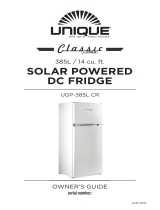
16
TROUBLESHOOTING
Before contacting a service technician, your local product dealer or
Unique O-Grid Appliances, please check the following points.
If you contact a technician to repair a fault listed below, or to repair a
fault caused by misuse, abuse, or faulty installation, a charge will be
made even if the appliance is under warranty.
PROBLEM SOLUTION
Appliance is
connected
to power,
but does not
operate
• Check if 12V or 24V DC is present at the
appliance. If not, check all connections and the
system battery voltage.
• Check that the polarity is correct: positive (+)
is connected to positive (+), and negative (-) is
connected to negative (-).
• Check the fuse. If blown, replace with a new one
(see page 11 for details).
• The primary problem with a non-functioning
appliance is due to a voltage drop to the
compressor, which causes the unit to fail
to start due to “low voltage”. Typically a
connection is not as tight as it should be, or the
wire size to the compressor is too small. The
low voltage problem occurs instantly at start-up
and can be dicult to detect with a volt meter
because it happens so quickly (<100ms)
Appliance is
operating, but
the interior
(cabinet) is not
cold
• Allow the appliance at least 4 hrs to cool down
once turned on.
• Check that the thermostat control knob is
turned to the correct setting relevant to the
room/ambient temperatures.
• Check that the room/ambient temperature
is not approaching the internal operating
temperature and does not exceed to 100˚F
(38˚C).
• Has too much warm food been added to the
freezer recently? If so, it will take some time for
the appliance to return to temperature.
• Does the cabinet have adequate ventilation
around the side walls, allowing it to transfer
heat properly? (See Installation section)
The door will
not open
• Has the door just been opened? If so, leave the
appliance closed for a few minutes to allow the
air pressure to equalize and try again.




























